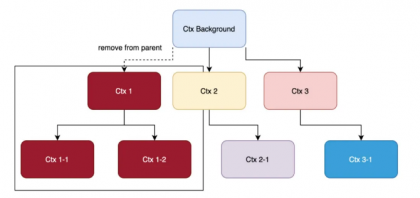Go Context 最佳实践
时间:2021-9-26 作者:smarteng 分类: Go语言
尽管有人说Context should go away in GO2^[1]^, 但是现有的代码中还是大量使用 Context , 并不是每个人都了解 Context , 从去年到现在就见过两次因为错误使用导致的问题。每个同学都会踩到坑,今天分享下 Context 库使用的 Dos and Don'ts
使用场景
Context 主要有以下三种使用场景
- 传递超时信息,这点用的最多
- 传递信号,用于消息通知,处理多协程通信
- 传递数据,常用的框架层 trace-id, metadata
举一个 etcd watch 的例子,我们加深了解
func watch(ctx context.Context, revision int64) {
ctx, cancel := context.WithCancel(ctx)
defer cancel()
for {
rch := watcher.Watch(ctx, watchPath, clientv3.WithRev(revision))
for wresp := range rch {
......
doSomething()
}
select {
case <-ctx.Done():
// server closed, return
return
default:
}
}
}首先基于参数传进来的 parent ctx 生成了 child ctx 与 cancel 函数。然后 Watch 时传入 child ctx , 如果此时 parent ctx 被外层 cancel , child ctx 也会被级联 cancel , rch 会被 etcd 关闭,然后 for 循环走到 select 逻辑,此时 child ctx 被取消了,所以 <-ctx.Done() 生效, watch 函数返回
其于 context 可以很好的做到多个 goroutine 协作,超时管理,大大简化了开发工作。这也是 Go 的魅力
原理
type Context interface {
Deadline() (deadline time.Time, ok bool)
Done() <-chan struct{}
Err() error
Value(key interface{}) interface{}
}Context 是一个接口
Deadlinectx 如果在某个时间点关闭的话,返回该值。否则 ok 为 falseDone返回一个 channel, 如果超时或是取消就会被关闭,实现消息通讯Err如果当前 ctx 超时或被取消了,那么 Err 返回错误Value根据某个 key 返回对应的 value, 功能类似字典
目前的实现有 emptyCtx , valueCtx , cancelCtx , timerCtx . 可以基于某个 Parent 派生成 Child Context
func WithValue(parent Context, key, val interface{}) Context
func WithCancel(parent Context) (Context, CancelFunc)
func WithDeadline(parent Context, d time.Time) (Context, CancelFunc)
func WithTimeout(parent Context, timeout time.Duration) (Context, CancelFunc)经过多次派生后,ctx 是一个类似多叉树的结构。当 ctx-1 被 cancel 时,会级联 cancel 以 ctx-1 为根的整棵树,但是原来的 root, ctx2 ctx3 不受影响
func (c *cancelCtx) cancel(removeFromParent bool, err error) {
if err == nil {
panic("context: internal error: missing cancel error")
}
c.mu.Lock()
if c.err != nil {
c.mu.Unlock()
return // already canceled
}
c.err = err
d, _ := c.done.Load().(chan struct{})
if d == nil {
c.done.Store(closedchan)
} else {
close(d)
}
for child := range c.children {
// NOTE: acquiring the child's lock while holding parent's lock.
child.cancel(false, err)
}
c.children = nil
c.mu.Unlock()
if removeFromParent {
removeChild(c.Context, c)
}
}首先检测 done channel, 如果有人监听,那么 close 掉,这时所有 wait 这个 ctx 的 goroutines 都会收到消息
然后遍历 children map, 依次 cancel 所有 child, 这里类似树的先序遍历。最后 removeFromParent 将自己从父节点中摘除
几个问题
打印 Ctx
以 WithCancel 为例子,可以看到 child 同时引用了 parent, 而 propagateCancel 函数的存在,parent 也会引用 child(当 parent 是 cancelCtx 类型时)
func WithCancel(parent Context) (ctx Context, cancel CancelFunc) {
c := newCancelCtx(parent)
propagateCancel(parent, &amp;c)
return &amp;c, func() { c.cancel(true, Canceled) }
}
// newCancelCtx returns an initialized cancelCtx.
func newCancelCtx(parent Context) cancelCtx {
return cancelCtx{Context: parent}
}如果此时打印 ctx, 就会递归调用 String() 方法,就会把 key/value 打印出来。如果此时 value 是非线程安全的,比如 map, 就会引发 concurrent read and write panic
这个案例就是 http 标准库的实现 server.go:2906^[2]^ 行代码,把 http server 保存到 ctx 中
ctx := context.WithValue(baseCtx, ServerContextKey, srv)最后调用业务层代码时把 ctx 传给了用户
go c.serve(connCtx)如果此时打印 ctx, 就会打印 http srv 结构体,这里面就有 map. 感兴趣的可以做个实验,拿 ab 压测很容易复现
func stringify(v interface{}) string {
switch s := v.(type) {
case stringer:
return s.String()
case string:
return s
}
return "<not Stringer>"
}
func (c *valueCtx) String() string {
return contextName(c.Context) + ".WithValue(type " +
reflectlite.TypeOf(c.key).String() +
", val " + stringify(c.val) + ")"
}同时注意,后来 go 对此做了部份修复,一定程序上解决了问题。但也记住不要打印 ctx
Key/Value 类型不安全
// A valueCtx carries a key-value pair. It implements Value for that key and
// delegates all other calls to the embedded Context.
type valueCtx struct {
Context
key, val interface{}
}强烈不建义使用 Context 传递过多数据,这里可以看到 key / value 类型都是 interface{} , 编译期无法确定类型,运行期需要断言,有性能和安全问题
关闭底层连接
Context 超时会触发 http pool 关闭掉底层 connection, 导致连接频繁销重建,参考之前的文章超时控制一个反例
问题在于,要在哪层处理 tcp 无用数据,如果应用层读完再丢掉,此时连接还是可用的,但是操作系统 tcp stack 处理无用数据,那直接就 close. 而 grpc 就没这个问题,因为多路复用,每个请求都是虚拟的 stream, 如果超时,只需关闭 stream, 无需关闭底层 tcp 连接
双向链表
当 Context 派生层数比较多时,构成了一个双向链表, key / value 获取很有可能退化成 O(N) 操作,非常慢
type valueCtx struct {
Context
key, val interface{}
}
func WithValue(parent Context, key, val interface{}) Context {
if parent == nil {
panic("cannot create context from nil parent")
}
if key == nil {
panic("nil key")
}
if !reflectlite.TypeOf(key).Comparable() {
panic("key is not comparable")
}
return &amp;valueCtx{parent, key, val}
}
func (c *valueCtx) Value(key interface{}) interface{} {
if c.key == key {
return c.val
}
return c.Context.Value(key)
}每当添加一个 key / value 时都会生成新的 valueCtx , 查询时,如果当前 ctx 不存在 key , 则递归查询 c.Context
提前超时
func test(){
ctx, cancel := context.WithCancel(ctx)
defer cancel()
doSomething(ctx)
}
func doSomething(ctx){
go doOthers(ctx)
}当调用栈较深,多人合作时很容易产生这种情况。其实还是没明白 ctx cancel 工作原理,异步 go 出去的业务逻辑需要基于 context.Background() 再派生 child ctx, 否则就会提前超时返回
另外大家容易忽略的点,默认情况下 grpc 会透传超时时间的,比如入口 A 服务调 B, 超时设置了 2s, B 如果用同一个 Context 去调下游 C, 那么超时就要减去 B 自己处理的时间。如果链路比较长,很可能到达 G 服务时就己经超时了
传递超时可以提前释放资源,否则入口超时了,后端还在处理请求
自定义 Ctx
非常不建义自定义 Context , 原因在于源码中处理是不同的
// propagateCancel arranges for child to be canceled when parent is.
func propagateCancel(parent Context, child canceler) {
......
if p, ok := parentCancelCtx(parent); ok {
p.mu.Lock()
if p.err != nil {
......
} else {
......
p.children[child] = struct{}{}
}
p.mu.Unlock()
} else {
atomic.AddInt32(&amp;goroutines, +1)
go func() {
select {
case <-parent.Done():
child.cancel(false, parent.Err())
case <-child.Done():
}
}()
}
}
func parentCancelCtx(parent Context) (*cancelCtx, bool) {
......
p, ok := parent.Value(&amp;cancelCtxKey).(*cancelCtx)
if !ok {
return nil, false
}
......
return p, true
}通过源码可知, parent 引用 child 有两种方式,官方 cancelCtx 类型的是用 map 保存。但是非官方的需要开启 goroutine 去监测。本来业务代码己经 goroutine 满天飞了,不加节制的使用只会增加系统负担
使用建议
最后来总结下 context 使用的几个原则:
- 除了框架层不要使用
WithValue携带业务数据,这个类型是interface{}, 编译期无法确定,运行时assert 有开销。如果真要携带也要用 thread-safe 的数据 - 一定不要打印
Context, 尤其是从http标准库派生出来的,谁知道里面存了什么 Context通常做为第一个参数传给函数,但如果Context生命周期等同于结构体,当成结构体成员也可以- 尽可能不要自定义用户层
Context, 除非收益巨大 - 异步 goroutine 逻辑使用
Context时要清楚谁还持有,会不会提前超时,尤其调 rpc, db, redis 时 - 派生出来的 child ctx 一定要配合 defer cancel() 使用,释放资源

